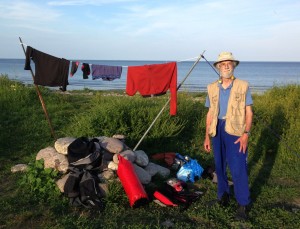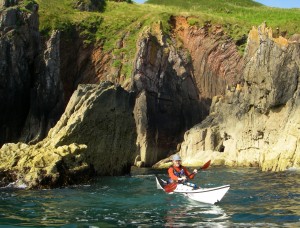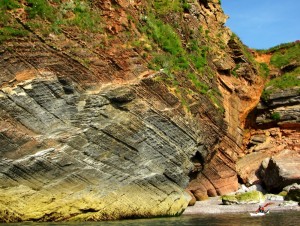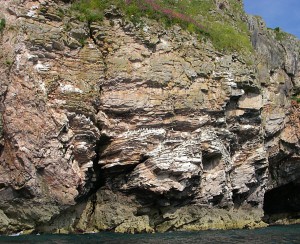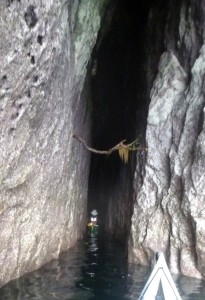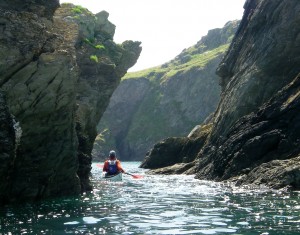The 17 km between Dartmouth and Brixham includes spectacular cliff scenery and varied geology, together with abundant wildlife. On this warm sunny June afternoon we made a promising start in light wind and calm sea. Our destination was Man Sands, a little over half way to Brixham.
We landed on a spacious beach with just one family party enjoying the evening with beach cricket and a barbecue.
I hastened to use the last rays of sunshine to dry my clothes. The Greenland style paddle is a versatile design, being well suited to jamming into a stone cairn. The other pole is a modern aluminium tube, but I aim to perfect a dividable paddle suited also to holding up bivouacs and clothes lines.
The night started well enough. Then at half past midnight a bunch of youths stumbled by and set up two tents nearby with loud instructions and a tinny ipad adding to the noise. I thumped on the tent to ask for no noise but did not expect any improvement in consideration for other campers, so I grabbed my underlay and sleeping bag and climbed to the top of the hill for a peaceful night under the stars. I think we should not brag about British Values; instead teach courtesy and consideration.
The next day revealed a surprising number of overnight residents of this fairly remote beach. As I climbed down from the hilltop I passed another sparsely equipped elderly bivouaker and politely asked if he was travelling far. That was a mistake since he travelled back in time to his o-level exams, which was the start of a campaign by a malevolent society that resulted in his now being a homeless wanderer. There was also a small tent tucked in round a rocky corner with a couple of seasoned campers who evidently knew accurately the tidal range. As I prepared breakfast with my paddling companion Eugene, a horse appeared with young rider, sedately crossing the sunny beach in the engaging manner of tourist adverts for far off places, such as Ireland. Nevertheless, we decided to blacklist Man Sands as an overnight stop.
Eugene wanted to reach breakfast at the beach cafe in Brixham, before it vanished in favour of the lunch menu. So we started off against a brisk opposing wind, with me fuelled by porridge with strawberries, and Eugene driven mainly by hunger.
This coast has wonderfully varied geology, nearly continuously exposed in the cliffs. Here, in the stretch west from Sharkham point, a basalt sill has sneaked between the layers of sediment and cooled from the side, maybe by fluids in the zone of weakness now represented by the eroded fissure, so that the cooling cracks developed horizontal hexagonal columns (on the right side of the prominent gully – need to zoom the image).
Round the corner of Sharkham point, limestone layers are tilted vertical and crumpled into tight folds. But as one goes west towards the massive reef limestone of Berry Head, the strata become more uniform and gently tilted.
Paddling on beside the dramatic cliffs under the southern fort of the Berry Head defensive architecture, we disturb a flock of guillemots sitting on the water. Their nests are on the cliff above.
This is a high resolution image which just about shows the black backed guillemots standing neatly arranged on the narrow ledges. This is a large colony of birds which only come ashore to breed, so I was sad that we had disturbed them. This nature reserve is exposed to pleasure craft from Brixham. Outside the nesting season, the birds take to the open sea and rock climbers move onto the cliff.
The Berry Head limestone is riddled with caves, inhabited by bats, including the rare greater horseshoe bat, whose roosts here are protected, and also their feeding zones and river valley flypaths. One impressively large cave is accessible from the sea.
There are many other caves which can be explored by narrow boats on calm days. The driftwood branch lodged in this cleft illustrates the variable water level.
A variable water level greeted us as we rounded Berry Head. I had naively assumed that at the neap, the tide race would be easy to penetrate, but the white foaming waves were scary and forced defensive bracing strokes which I have hardly ever needed. The numerous fishing lines deployed from the shore make hugging the shoreline unpopular, further out the wave height increases. The middle route remained rough for much of the way to Brixham breakwater.
Breakfast was still being served at the beach cafe. I had an early lunch of fish pie. We agreed that returning through the raging waters would be unwise with just the two of us. However, our telephone calls for a car to transport us back the short distance to Kingswear went unanswered. A smartphone app showed that we had tackled the tide race at its maximum speed, so that after a leisurely brunch, we might find the sea less intimidating. So it proved. The Berry Head race is the only hazard on this route, in good weather, so we must explore the walking route from St Mary’s bay over to the refreshments of Brixham, and also over the botanical paradise of the nature reserve limestone grassland.
Our return was uneventful, with weak following wind and an opposing tide. The day’s journey of at least 26 km is about my comfort limit as an aging paddler but we took advantage of the slack water through several inner passages along the coast, like this one near Ivy cove.
tim

